Page 91 of 306
SUNGLASSES HOLDERThe sunglasses holder can be opened by push-
ing the button.
WARNING
The sunglasses holder should not be
used while driving so full attention may
be given to vehicle operation.
CAUTION
�Do not use for anything other than
glasses.
�Do not leave glasses in the sun-
glasses holder while parking in direct
sunlight. The heat may damage the
glasses.
SIC0557
Instruments and controls
2-31
�
04.3.9/R50-D/V5
�
Page 100 of 306
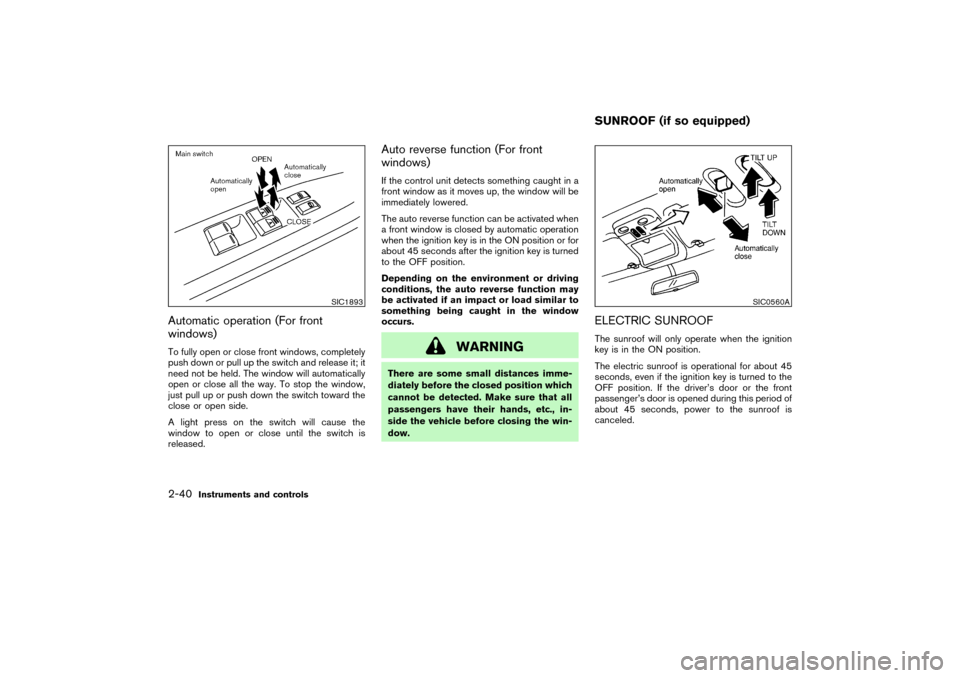
Automatic operation (For front
windows)To fully open or close front windows, completely
push down or pull up the switch and release it; it
need not be held. The window will automatically
open or close all the way. To stop the window,
just pull up or push down the switch toward the
close or open side.
A light press on the switch will cause the
window to open or close until the switch is
released.
Auto reverse function (For front
windows)If the control unit detects something caught in a
front window as it moves up, the window will be
immediately lowered.
The auto reverse function can be activated when
a front window is closed by automatic operation
when the ignition key is in the ON position or for
about 45 seconds after the ignition key is turned
to the OFF position.
Depending on the environment or driving
conditions, the auto reverse function may
be activated if an impact or load similar to
something being caught in the window
occurs.
WARNING
There are some small distances imme-
diately before the closed position which
cannot be detected. Make sure that all
passengers have their hands, etc., in-
side the vehicle before closing the win-
dow.
ELECTRIC SUNROOFThe sunroof will only operate when the ignition
key is in the ON position.
The electric sunroof is operational for about 45
seconds, even if the ignition key is turned to the
OFF position. If the driver’s door or the front
passenger’s door is opened during this period of
about 45 seconds, power to the sunroof is
canceled.
SIC1893
SIC0560A
SUNROOF (if so equipped)
2-40
Instruments and controls
�
04.3.9/R50-D/V5
�
Page 102 of 306
The shade will open automatically when the
sunroof is opened. However, it must be closed
manually.
WARNING
�In an accident you could be thrown
from the vehicle through an open
sunroof. Always use seat belts and
child restraints.
�Do not allow anyone to stand up or
extend any portion of their body out
of the opening while the vehicle is in
motion or while the sunroof is clos-
ing.
CAUTION
�Remove water drops, snow, ice or
sand from the sunroof before open-
ing.
�Do not place any heavy object on the
sunroof or surrounding area.
If the sunroof does not closeHave your NISSAN dealer check and repair the
sunroof.
The lights have a three-position switch.
When the switch is in the center�position, the
lights will illuminate when a door or the back
door is opened.
SIC0564A
INTERIOR LIGHTS (if so
equipped)
2-42
Instruments and controls
�
04.3.9/R50-D/V5
�
Page 105 of 306
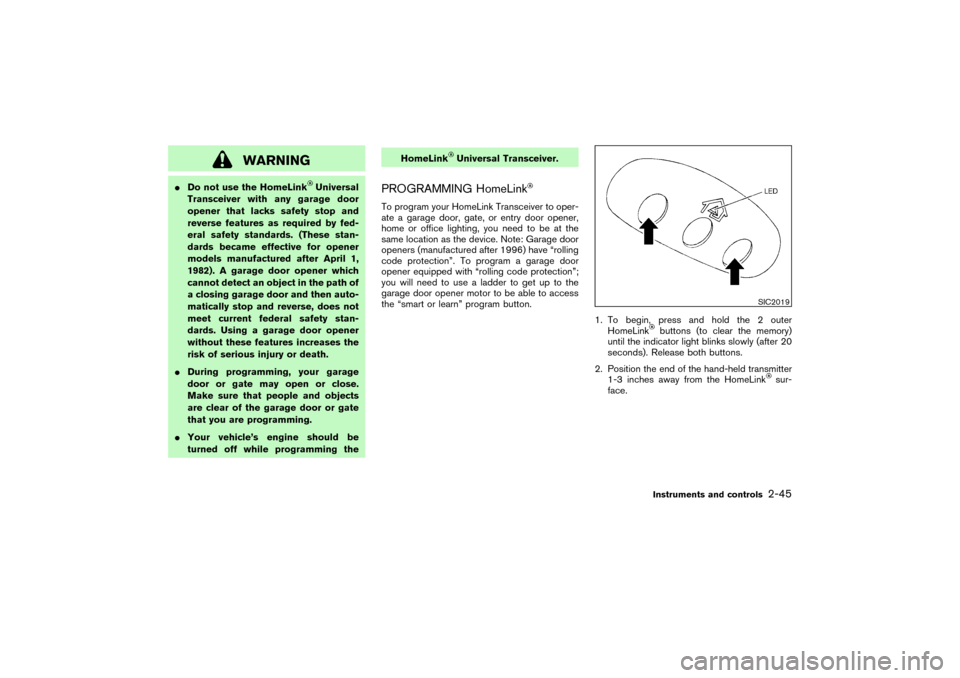
WARNING
�Do not use the HomeLink
Universal
Transceiver with any garage door
opener that lacks safety stop and
reverse features as required by fed-
eral safety standards. (These stan-
dards became effective for opener
models manufactured after April 1,
1982). A garage door opener which
cannot detect an object in the path of
a closing garage door and then auto-
matically stop and reverse, does not
meet current federal safety stan-
dards. Using a garage door opener
without these features increases the
risk of serious injury or death.
�During programming, your garage
door or gate may open or close.
Make sure that people and objects
are clear of the garage door or gate
that you are programming.
�Your vehicle’s engine should be
turned off while programming theHomeLink
Universal Transceiver.
PROGRAMMING HomeLinkTo program your HomeLink Transceiver to oper-
ate a garage door, gate, or entry door opener,
home or office lighting, you need to be at the
same location as the device. Note: Garage door
openers (manufactured after 1996) have “rolling
code protection”. To program a garage door
opener equipped with “rolling code protection”;
you will need to use a ladder to get up to the
garage door opener motor to be able to access
the “smart or learn” program button.
1. To begin, press and hold the 2 outer
HomeLink
buttons (to clear the memory)
until the indicator light blinks slowly (after 20
seconds). Release both buttons.
2. Position the end of the hand-held transmitter
1-3 inches away from the HomeLink
sur-
face.
SIC2019
Instruments and controls
2-45
�
04.3.9/R50-D/V5
�
Page 118 of 306
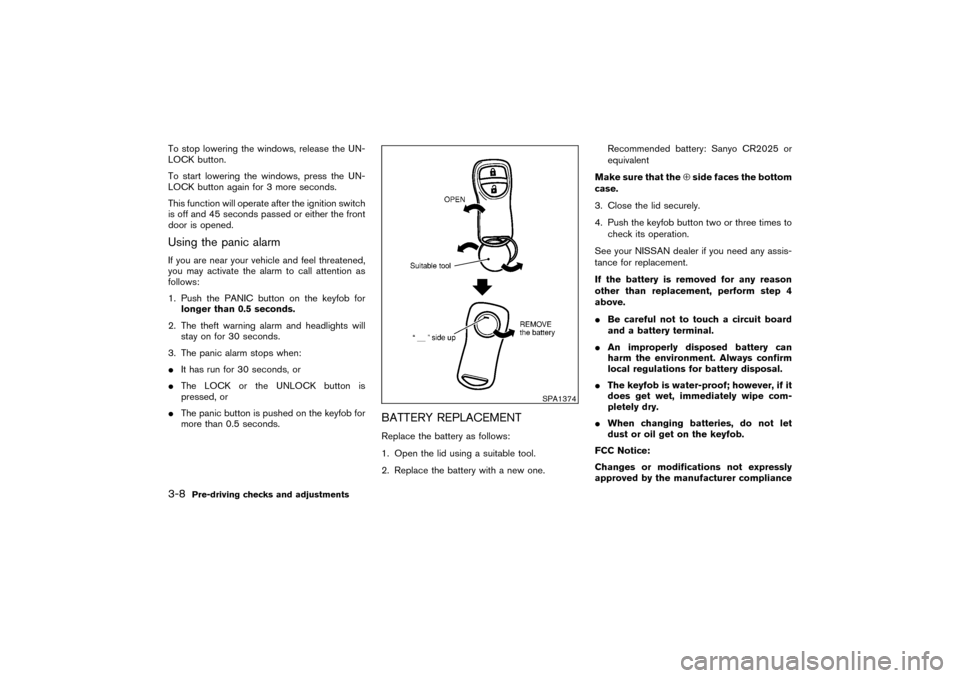
To stop lowering the windows, release the UN-
LOCK button.
To start lowering the windows, press the UN-
LOCK button again for 3 more seconds.
This function will operate after the ignition switch
is off and 45 seconds passed or either the front
door is opened.Using the panic alarmIf you are near your vehicle and feel threatened,
you may activate the alarm to call attention as
follows:
1. Push the PANIC button on the keyfob for
longer than 0.5 seconds.
2. The theft warning alarm and headlights will
stay on for 30 seconds.
3. The panic alarm stops when:
�It has run for 30 seconds, or
�The LOCK or the UNLOCK button is
pressed, or
�The panic button is pushed on the keyfob for
more than 0.5 seconds.
BATTERY REPLACEMENTReplace the battery as follows:
1. Open the lid using a suitable tool.
2. Replace the battery with a new one.Recommended battery: Sanyo CR2025 or
equivalent
Make sure that the⊕side faces the bottom
case.
3. Close the lid securely.
4. Push the keyfobbutton two or three times to
check its operation.
See your NISSAN dealer if you need any assis-
tance for replacement.
If the battery is removed for any reason
other than replacement, perform step 4
above.
�Be careful not to touch a circuit board
and a battery terminal.
�An improperly disposed battery can
harm the environment. Always confirm
local regulations for battery disposal.
�The keyfob is water-proof; however, if it
does get wet, immediately wipe com-
pletely dry.
�When changing batteries, do not let
dust or oil get on the keyfob.
FCC Notice:
Changes or modifications not expressly
approved by the manufacturer compliance
SPA1374
3-8
Pre-driving checks and adjustments
�
04.3.9/R50-D/V5
�
Page 119 of 306
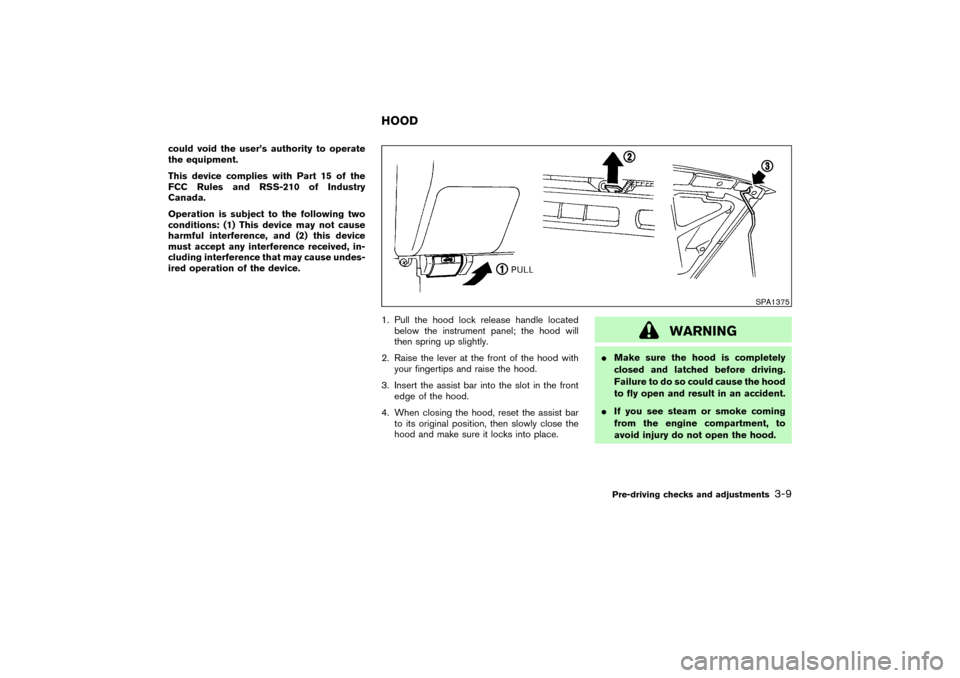
could void the user’s authority to operate
the equipment.
This device complies with Part 15 of the
FCC Rules and RSS-210 of Industry
Canada.
Operation is subject to the following two
conditions: (1) This device may not cause
harmful interference, and (2) this device
must accept any interference received, in-
cluding interference that may cause undes-
ired operation of the device.
1. Pull the hood lock release handle located
below the instrument panel; the hood will
then spring up slightly.
2. Raise the lever at the front of the hood with
your fingertips and raise the hood.
3. Insert the assist bar into the slot in the front
edge of the hood.
4. When closing the hood, reset the assist bar
to its original position, then slowly close the
hood and make sure it locks into place.
WARNING
�Make sure the hood is completely
closed and latched before driving.
Failure to do so could cause the hood
to fly open and result in an accident.
�If you see steam or smoke coming
from the engine compartment, to
avoid injury do not open the hood.
SPA1375
HOOD
Pre-driving checks and adjustments
3-9
�
04.3.9/R50-D/V5
�
Page 126 of 306
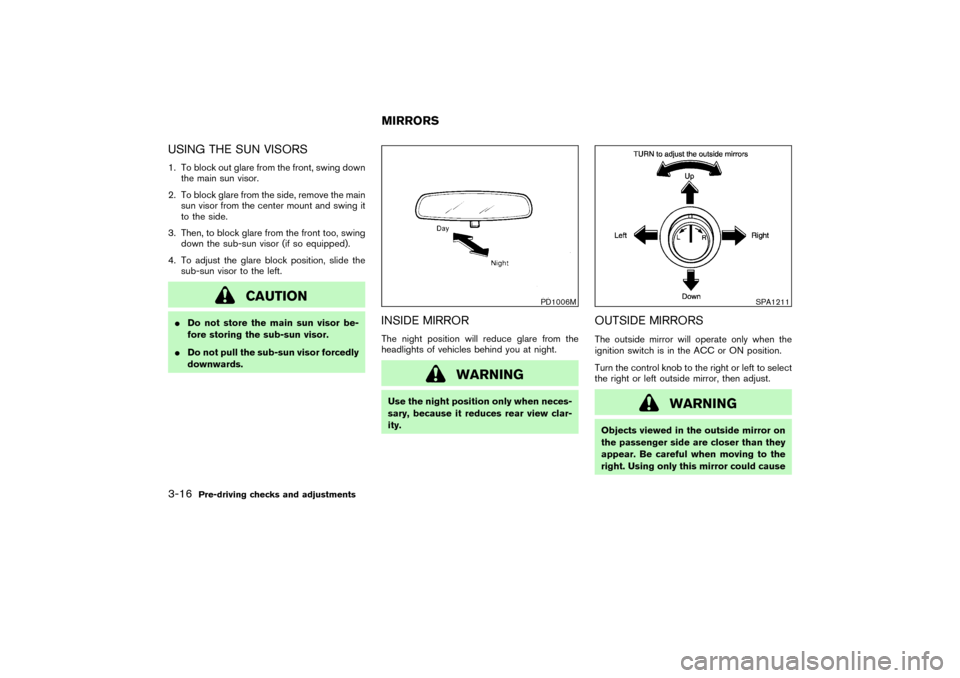
USING THE SUN VISORS1. To block out glare from the front, swing down
the main sun visor.
2. To block glare from the side, remove the main
sun visor from the center mount and swing it
to the side.
3. Then, to block glare from the front too, swing
down the sub-sun visor (if so equipped).
4. To adjust the glare block position, slide the
sub-sun visor to the left.
CAUTION
�Do not store the main sun visor be-
fore storing the sub-sun visor.
�Do not pull the sub-sun visor forcedly
downwards.
INSIDE MIRRORThe night position will reduce glare from the
headlights of vehicles behind you at night.
WARNING
Use the night position only when neces-
sary, because it reduces rear view clar-
ity.
OUTSIDE MIRRORSThe outside mirror will operate only when the
ignition switch is in the ACC or ON position.
Turn the control knobto the right or left to select
the right or left outside mirror, then adjust.
WARNING
Objects viewed in the outside mirror on
the passenger side are closer than they
appear. Be careful when moving to the
right. Using only this mirror could cause
PD1006M
SPA1211
MIRRORS
3-16
Pre-driving checks and adjustments
�
04.3.9/R50-D/V5
�
Page 165 of 306
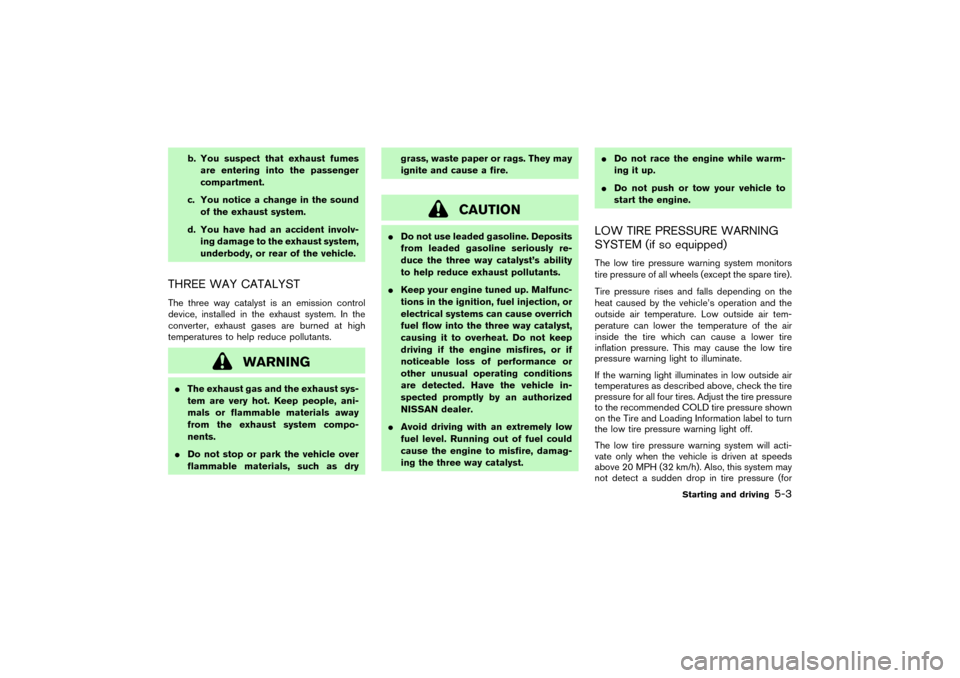
b. You suspect that exhaust fumes
are entering into the passenger
compartment.
c. You notice a change in the sound
of the exhaust system.
d. You have had an accident involv-
ing damage to the exhaust system,
underbody, or rear of the vehicle.
THREE WAY CATALYSTThe three way catalyst is an emission control
device, installed in the exhaust system. In the
converter, exhaust gases are burned at high
temperatures to help reduce pollutants.
WARNING
�The exhaust gas and the exhaust sys-
tem are very hot. Keep people, ani-
mals or flammable materials away
from the exhaust system compo-
nents.
�Do not stop or park the vehicle over
flammable materials, such as drygrass, waste paper or rags. They may
ignite and cause a fire.
CAUTION
�Do not use leaded gasoline. Deposits
from leaded gasoline seriously re-
duce the three way catalyst’s ability
to help reduce exhaust pollutants.
�Keep your engine tuned up. Malfunc-
tions in the ignition, fuel injection, or
electrical systems can cause overrich
fuel flow into the three way catalyst,
causing it to overheat. Do not keep
driving if the engine misfires, or if
noticeable loss of performance or
other unusual operating conditions
are detected. Have the vehicle in-
spected promptly by an authorized
NISSAN dealer.
�Avoid driving with an extremely low
fuel level. Running out of fuel could
cause the engine to misfire, damag-
ing the three way catalyst.�Do not race the engine while warm-
ing it up.
�Do not push or tow your vehicle to
start the engine.
LOW TIRE PRESSURE WARNING
SYSTEM (if so equipped)The low tire pressure warning system monitors
tire pressure of all wheels (except the spare tire).
Tire pressure rises and falls depending on the
heat caused by the vehicle’s operation and the
outside air temperature. Low outside air tem-
perature can lower the temperature of the air
inside the tire which can cause a lower tire
inflation pressure. This may cause the low tire
pressure warning light to illuminate.
If the warning light illuminates in low outside air
temperatures as described above, check the tire
pressure for all four tires. Adjust the tire pressure
to the recommended COLD tire pressure shown
on the Tire and Loading Information label to turn
the low tire pressure warning light off.
The low tire pressure warning system will acti-
vate only when the vehicle is driven at speeds
above 20 MPH (32 km/h). Also, this system may
not detect a sudden drop in tire pressure (for
Starting and driving
5-3
�
04.3.9/R50-D/V5
�